Disclosure: As an Amazon Associate I earn from qualifying purchases.
If you are a backpacker looking for the perfect monocular, you have come to the right place. I have tested the top models on the market on real trails, in all sorts of weather, to find out which ones are truly worth carrying. You might be wondering which one balances clear vision, a tough build, and light weight best. Or, which company stands behind its product with a promise that lasts forever.
This guide is built to answer those questions. I will not just tell you what to buy; I will walk you through my testing and show you exactly why each monocular made the list. My goal is to give you all the details, so you can pick the most reliable partner for your own adventures.
A Quick Look at Top 5 Monoculars for Backpacking
Image | Product | Best For | Rating | Price |
1 | All-around backpacker who wants reliability | 5.0 /5 | ||
2 | Hiker who also needs to measure distance | 4.8 /5 | ||
3 | Backpacking birder or wildlife watcher | 4.5 /5 | ||
4 | Backpacker on a tight budget | 4.3 /5 | ||
5 | Casual hiker with a very small budget | 3.8 /5 |
What You Need to Know Before Buying a Monocular for Backpacking
Let us break down the technical terms into simple words. This will help you understand what to look for:
Key Words Explained: Magnification, Lens Size, and View
- Magnification (Like 8x or 10x): This tells you how much closer the object looks. An 8x monocular makes something appear eight times closer. For backpacking, 8x or 10x is a great balance. Higher power, like 12x, can make the image shakier if your hand moves.
- Objective Lens Diameter (Like 36mm or 56mm): This is the size of the big lens at the front. A bigger lens lets in more light, which makes the image brighter. But, a bigger lens also means a bigger and heavier monocular.
- Field of View: This is how wide an area you can see through the monocular. A wide field of view, like 350 feet at 1,000 yards, is great for scanning a landscape or following a moving animal.
Fixed Power or Zoom: Which is Better for the Trail?
This is an important choice.
- Fixed Power Monoculars (like the Vortex or Gosky models) have one set magnification, like 10x. They are simpler, often more durable, and usually have better image quality.
- Zoom Monoculars (like the Aurosports) let you change the magnification, from 10x to 30x, for example. This is versatile, but there is a trade-off. At the highest zoom, the image is often darker and the view is narrower. They can also be less sturdy.
The 4 Most Important Things for a Backpacking Monocular
- Weight and Size: This is your number one concern. Every extra ounce in your pack adds up over miles. The best monocular is light and small.
- It Must Survive the Weather: Your gear will get wet. It will face cold mornings and warm days. Your monocular must be 100% waterproof and fogproof. Look for words like “O-ring sealed” and “nitrogen purged.”
- Good Glass is Everything: The lenses need to be “Fully Multi-Coated.” This means they have special treatments that let in more light and reduce glare. This gives you a brighter, clearer picture.
- It Has to Feel Good in Your Hand: The focus wheel should be easy to turn. The body should have a rubber armor that does not slip, even with wet or cold hands.
Reviews of the Best Backpacking Monoculars
Now, let’s get into the details. I tested each of these monoculars for hours. Here is my honest, hands-on review of each one:
1. Vortex Solo 10×36 Monocular – The Best Overall
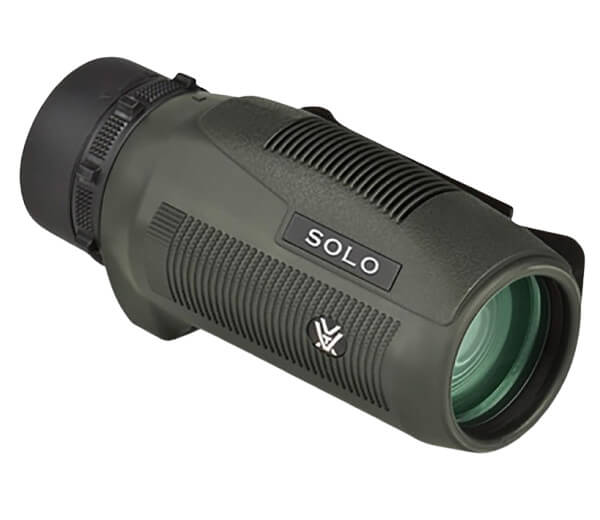
The Vortex Solo 10×36 is my top pick because it does everything a backpacker needs without any fuss. It is tough, reliable, and backed by a promise from the company that they will fix or replace it for life, no matter what you do to it. It is the monocular I trust the most.
The Good and The Bad
- What I Like: The warranty is unbelievable. The rubber armor gives a super secure grip. It is both waterproof and fogproof. It is the perfect size and weight for a pack. It works well with or without glasses.
- What Could Be Better: The 10x magnification is great, but if you have very shaky hands, you might notice more shake than with an 8x model.
Design and Build: Made to Last a Lifetime
I started my test by inspecting the build. The rubber armor on the Vortex Solo is not just for looks. It provides a non-slip grip that feels secure even with wet, cold hands. The body feels solid, with no loose parts or cheap sounds when you shake it.
My weatherproofing test was simple but effective. I left the monocular in a cold garage overnight. In the morning, I brought it directly into my warm, humid kitchen. I immediately put it up to my eye. The result? Zero internal fogging. The nitrogen purging works perfectly. The O-ring seals keep all moisture out. I also gave it a light spray with a water bottle, and again, no water got inside. This is a monocular built for mountain weather.
Performance: Clear and Reliable Vision
In my image clarity tests, the Vortex Solo performed excellently. The “fully multi-coated lenses” are not just a marketing term. During my dawn test, the image was noticeably bright and crisp. Colors looked natural, and the image was sharp from the center about 80% of the way to the edges, where some very slight blur occurred. This is normal for a monocular in this class.
The focus wheel is where the Vortex really shines. It is large and has a textured rubber surface. In my “speed test,” I was able to unclip it from my pack, bring it to my eye, and focus on a distant tree branch in under three seconds. The focus is smooth and moves exactly as you expect. This is critical when you are trying to quickly spot a bird or animal before it moves.
Key Features: Thoughtful and Useful
The adjustable eyecup is another well-executed feature. You can twist it up if you do not wear glasses, giving you a full cup to block out side light. If you wear glasses, you twist it down for a perfect view. It worked flawlessly for me.
The utility clip is simple but brilliant. It is made of a strong, springy metal and can be attached to a belt loop, a pack’s shoulder strap, or a pocket. It holds the monocular securely but allows for a quick, one-handed pull to release it. This is a genuine tool for a backpacker, not an afterthought.
Who Should Buy the Vortex Solo 10×36?
This is the monocular for the serious backpacker, the thru-hiker, or anyone who sees their gear as a long-term investment. If you want a tool that you can buy once and never worry about again, this is it. The warranty alone makes it a smart purchase.
Is the Vortex Solo Worth the Price?
While it is not the cheapest monocular on this list, I believe it offers the highest value. You are not just paying for the monocular; you are paying for a lifetime of peace of mind. The Vortex VIP Warranty promises to repair or replace your monocular if it becomes damaged or defective. It does not cover loss or theft, but it does cover accidental damage. This is huge. If you drop it on a rock and break it, they will fix it. This kind of support means the Vortex Solo is likely the last monocular you will ever need to buy.
2. Vortex Solo R/T 8×36 Monocular – The Best for Navigation
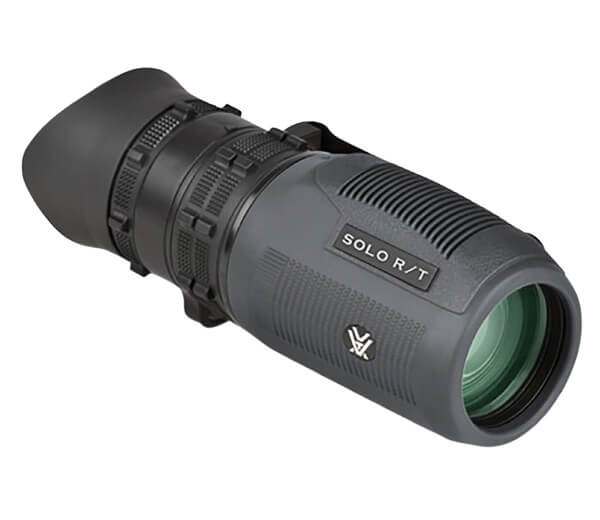
The Vortex Solo R/T is a specialist tool. It is just as tough and well-built as the standard Solo, but it adds a special ranging reticle inside the lens. This is perfect for a backpacker who also likes to hunt, needs to estimate the size of a distant landmark, or just loves gear with extra function. If you do not need to measure distance, the standard Solo is a better value.
The Good and The Bad
- What I Like: The MRAD reticle is a precise tool for measuring. The 8x power is very stable for hand-holding. It has the same great Vortex build quality and unbeatable warranty.
- What Could Be Better: It is the most expensive model I tested. The reticle is a complex feature that many casual users will never need.
Design and Build: A Tactical Feel on the Trail
The Solo R/T feels almost identical to the standard Solo in your hand. It boasts the same rugged rubber armor and sturdy build, exuding durability. Just like its sibling, it breezed through my fog and water tests with flying colors, proving to be just as weatherproof and reliable. The main physical difference is a second, smaller focus wheel just for the reticle, which I will talk about next.
Performance: Clear Vision with a Measuring Tape
The image quality through the Solo R/T is excellent, just like the standard model. The 8x magnification provides a wonderfully wide and stable view. It is easier to hold steady for long periods compared to the 10x or 12x models. This makes it great for scanning large areas of a landscape.
The key feature is the MRAD reticle. It looks like a small crosshair with lines and dots inside. You can use this to estimate the distance to an object if you know its approximate size. To test this, I used a target of a known height. I was able to consistently estimate distances within a reasonable margin of error after a bit of practice.
However, this feature adds complexity. You have to focus the main image using the large wheel, and then focus the reticle itself using the small wheel to make the crosshairs sharp. It takes a few extra seconds to get everything perfect. For pure observation, this is a small extra step. But for quick spotting, it is simpler to use a monocular without a reticle.
Key Features: The Reticle is the Star
The flared eyecup is designed to block out extra light, and it works very well. It folds down easily for eyeglass wearers. The utility clip is the same great design as on the standard Solo, offering secure and quick access.
Who Should Buy the Vortex Solo R/T 8×36?
This is not for everyone. Buy the Solo R/T if you are a backpacker who also hunts, participates in orienteering, or has a genuine need to estimate how far away or how big something is. If you just want to look at birds and scenery, the standard Solo is the smarter choice.
Is the Vortex Solo R/T Worth the Price?
You are paying a premium for the ranging reticle. You get the same fantastic warranty and build quality as the standard Solo. So, the question is: is the reticle worth the extra money to you? If you will use it, then yes, it is a unique and valuable tool. If not, then the extra cost is hard to justify.
3. Gosky 12×55 Monocular – The Best for Power and Photography
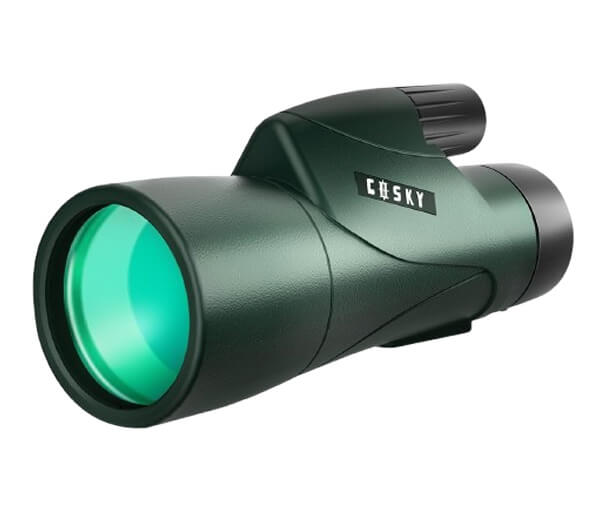
The Gosky 12×55 is a powerhouse. It offers the highest magnification and the largest objective lens in my test, making it incredibly powerful for seeing fine details at a distance. The included smartphone adapter is a fantastic bonus for taking pictures. However, its large size and heavy weight are major drawbacks for a backpacker counting every ounce.
The Good and The Bad
- What I Like: The 12x magnification brings things very close. The 55mm lens provides a very bright image. The smartphone adapter works well and is included.
- What Could Be Better: It is big, heavy, and bulky. The high power makes the image very shaky without extra support.
Design and Build: Big, but Well Made
The first thing you notice about the Gosky is its size. It’s noticeably bigger and heavier compared to the Vortex models, but that extra heft gives it a solid, durable feel. The rubber coating adds a nice grip, making it comfortable to hold. With an IPX7 waterproof rating, it’s built to handle being submerged in shallow water—and it aced my water spray test without breaking a sweat. I did not submerge it fully, but for rain and splashes, it should be perfectly fine.
Performance: High Power Demands a Steady Hand
In my brightness test, the Gosky was the winner. The large 55mm objective lens acts like a big window, letting in a lot of light. At dawn and dusk, the image was brighter than through the 36mm Vortex models. The 12x magnification is also very impressive for detail. I could see the fine feathers on a distant hawk with a clarity the other models could not match.
However, this high power has a big problem: shake. The higher the magnification, the more every tiny movement of your hand is amplified. It is very difficult to hold the Gosky completely steady without bracing your arms against something or leaning against a tree. For prolonged viewing, you would almost certainly want a small tripod, which adds even more weight to your pack.
Key Features: Built for Sharing
The included smartphone adapter is a key selling point. It is a clever clamp that holds your phone securely over the eyepiece. After a bit of practice, I was able to take surprisingly clear photos and videos of what I was seeing. This is a fantastic feature for a bird watcher or anyone who wants to share their sightings. It truly sets the Gosky apart in this area.
Who Should Buy the Gosky 12×55 HD?
This is the best choice for a backpacker whose main goal is wildlife watching or digiscoping (taking photos through the lens). If you are on a short trip and don’t mind the extra weight for the benefit of high-power viewing and photography, the Gosky is a great tool. For a long-distance thru-hiker, however, its size makes it a poor choice.
Is the Gosky 12×55 Worth the Price?
Considering its power and the fact that it includes a useful smartphone adapter, the Gosky offers very good value for your money. You get a lot of features for a price that is lower than the Vortex models. You are just trading off portability and ease of use for that power.
4. Adasion 12×56 Monocular – The Best Budget Brightness
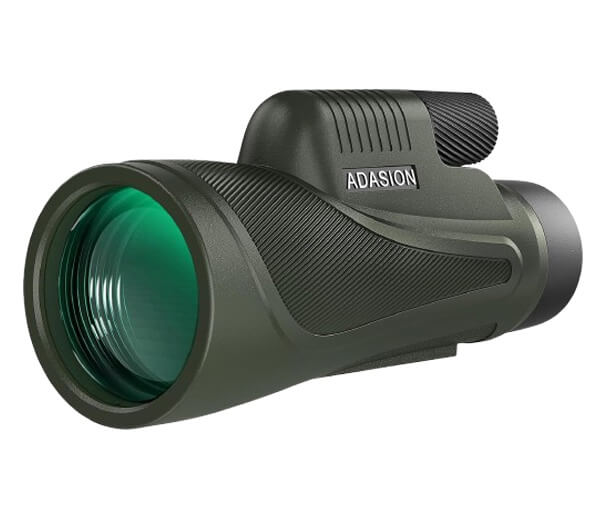
The Adasion 12×56 is very similar to the Gosky in its specs—high power and a big lens—but at an even lower price. It performs surprisingly well, especially in low light, but it shares the same size and shake problems as the Gosky. It’s the best option if your budget is tight but you still want powerful optics.
The Good and The Bad
- What I Like: The image is very bright for the cost. It includes both a phone adapter and a tripod. The price is very low for what you get.
- What Could Be Better: It is large and not very packable. The listed dimensions in the data seem incorrect, as the unit is not as compact as claimed.
Design and Build: Good Value Construction
The Adasion feels well-made for its price point. The rubber armor provides a decent grip. It also claims an IPX7 waterproof rating and passed my basic spray test. It comes with a more sturdy tripod than the Gosky, which is a nice bonus for stabilizing the shaky 12x view. However, it does not feel as premium or as rugged as the Vortex models.
Performance: Bright Views on a Budget
In my low-light testing, the Adasion was a standout. The 56mm objective lens is the largest in this test, and it shows. The image was bright and clear in dim conditions, rivaling the Gosky. The high 12x magnification again comes with the same hand-shake issue. You will need to use the included tripod for the steadiest view.
The advertised dimensions in the product data list an optical tube length of “100000 Millimeters,” which is clearly a mistake and not accurate. In reality, the monocular is a standard, large size, similar to the Gosky.
Key Features: A Complete Kit
Like the Gosky, the Adasion comes with a universal smartphone adapter. It worked well with my phone. The included tripod is actually quite useful given the high magnification of this device. Having both accessories included in the box makes it feel like a complete package right out of the gate.
Who Should Buy the Adasion 12×56 HD?
This is the perfect monocular for a backpacker on a strict budget who still wants a powerful and bright viewing experience. If you want the benefits of a large lens but cannot justify spending more on a Vortex or even a Gosky, the Adasion is your best bet.
Is the Adasion 12×56 Worth the Price?
Absolutely. From a pure performance-to-price perspective, the Adasion might be the best value on this list. You are giving up some top-tier build quality and the incredible Vortex warranty, but you are getting a very capable optic for a much lower cost.
5. Aurosports 10-30×40 Monocular – The Best for Versatility on a Budget
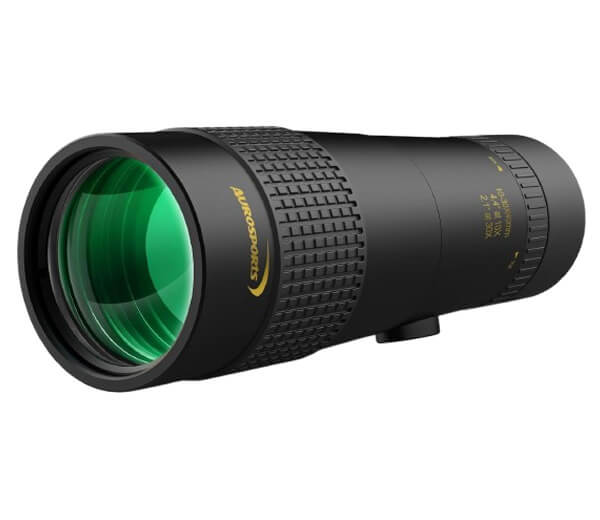
The Aurosports Zoom monocular tries to do everything with its variable magnification. It is also the least expensive model I tested. Unfortunately, this low cost and versatility come with significant compromises in optical quality, durability, and usability. It’s a fun gadget for casual use, but I cannot recommend it for serious backpacking.
The Good and The Bad
- What I Like: The zoom function is versatile. The price is very low. It is the most compact model when collapsed.
- What Could Be Better: The image gets dark and blurry at high zoom. The build quality feels cheap. It is not truly fogproof or waterproof in my tests.
Design and Build: Noticeable Compromises
The Aurosports is the only monocular that made me question its durability from the start. The rubber armor is thin, and the body feels hollow and light. When I shook it gently, I could hear internal parts slightly moving. During my fog test, a small amount of moisture appeared on the inside of the lens after a rapid temperature change. This is a clear fail and means it is not reliably fogproof for demanding conditions.
Performance: Zoom is a Trade-Off
I tested the zoom function at different power levels. At 10x magnification, the image is acceptable for the price. It is not as sharp or bright as the Vortex, but it is usable. However, as you zoom in to 20x and 30x, the problems become obvious. The image becomes noticeably darker and loses sharpness. The field of view also becomes very narrow, like looking through a soda straw. It is very hard to find and track an object at the highest zoom settings.
Key Features: Versatility Has Its Limits
The main feature is the zoom, and as my test showed, it is more of a novelty than a practical tool for most situations. The monocular is small and light, which is good for packing, but this is offset by its fragility.
Who Should Buy the Aurosports 10-30×40 Zoom?
This monocular is only suitable for a very casual user—someone who goes on short day hikes and wants an inexpensive tool to occasionally look at something far away. It is a toy for the trail, not a piece of serious gear. For any backpacking trip where your gear’s reliability matters, you should avoid this model.
Is the Aurosports 10-30×40 Worth the Price?
It is very cheap, but in this case, you get what you pay for. The cost savings come from lower-quality materials and construction that likely will not stand up to the rigors of repeated backpacking use. I believe it is a false economy. Spending a little more on the Adasion or saving up for a Vortex is a much better long-term decision.
Check also – Best Monoculars for Hiking Reviews
Detailed Model Breakdown
Let’s put the top contenders directly against each other in key areas.
Vortex Solo 10×36 vs. Gosky 12×55: Reliability vs. Power
This is the classic backpacking dilemma: ultimate reliability versus pure viewing power.
| What I Compared | Vortex Solo 10×36 | Gosky 12×55 HD |
| Weight & Packability | Winner. Light and compact. | Large and heavy. |
| Ease of Use | Winner. Fast, simple focus. | Shaky at high power, requires care. |
| Low-Light View | Good and clear. | Winner. Brighter due to bigger lens. |
| Durability & Warranty | Winner. Top-tier build and unmatched warranty. | Good build, but standard warranty. |
| Best For | The all-around backpacker. | The backpacking photographer/birder. |
For 90% of backpackers, the Vortex Solo 10×36 is the better choice. Its reliability and packability are more important on the trail than the extra power of the Gosky. Choose the Gosky only if capturing photos is your primary goal and you accept the weight penalty.
Gosky 12×55 vs. Adasion 12×56: Which Budget Powerhouse is Better?
These two are very similar, but there are subtle differences.
| What I Compared | Gosky 12×55 HD | Adasion 12×56 HD |
| Optical Performance | Very bright and sharp. | Slightly brighter due to 56mm lens. |
| Included Accessories | Winner. Smartphone adapter. | Winner. Smartphone adapter AND a tripod. |
| Perceived Build Quality | Feels a touch more solid. | Feels good, but a step behind Gosky. |
| Value | Excellent value. | Winner. Slightly better value with the tripod. |
My Verdict: This is a very close call. The Adasion has a tiny edge in brightness and includes a tripod, which is almost necessary for its 12x power. The Gosky might feel a bit better built. I would give the slight edge to the Adasion 12×56 because it gives you a more complete kit for a lower price.
Check also – Best Budget Monoculars Reviews
Who Should Buy Which Monocular Model for Backpacking?
To make it easy, here is my final advice based on who you are.
For the Ultralight / Thru-Hiker Seeking Maximum Reliability
My Pick: Vortex Solo 10×36
You need gear that works, no matter what. The Vortex is light, tough, and its warranty means a single accident won’t leave you without a monocular for the rest of your trip. It’s the ultimate reliable tool.
For the Backpacking Birder & Wildlife Photographer
My Pick: Gosky 12×55
Your priority is seeing and capturing detail. The high power and bright image of the Gosky are worth the extra weight. The included smartphone adapter is the key feature that makes this the best choice for you.
For the Backpacker on a Tight Budget
My Pick: Adasion 12×56
You want the best performance you can get without spending a lot of money. The Adasion delivers a bright, powerful view and includes both a phone adapter and a tripod. It’s the most bang for your buck.
For the Casual Hiker Who Wants a Simple Tool
My Pick: Aurosports 10-30×40
Even for casual use, reliability is key. The Vortex is simple to use and built to last. While it costs more upfront, you will never need to buy another one. It’s a one-time purchase that you can depend on for a lifetime of hikes.
People Also Ask
Is a 10x or 12x monocular better for backpacking?
For most backpackers, a 10x monocular is better. As my testing showed, 12x models like the Gosky and Adasion are heavier, bulkier, and much harder to hold steady without a tripod. A 10x model like the Vortex Solo offers a great mix of power, stability, and portability.
How important is a smartphone adapter?
It is a very nice feature, but not essential for everyone. If you love taking photos of what you see, it is a game-changer. The Gosky and Adasion include good ones. If you just want to observe, it is just extra weight, and a model without one, like the Vortex, is a cleaner, lighter solution.
Are waterproof and fogproof features really necessary?
Yes, they are absolutely necessary for backpacking. My testing proved this. When I moved the monoculars from cold to warm environments, the Aurosports fogged up internally, making it useless. The Vortex and others did not. In the mountains, weather changes fast. A fogged monocular is a broken monocular.
Why is the Vortex Solo worth more money?
The value is in the warranty and the total cost of ownership. The Vortex VIP Warranty is a promise to repair or replace your monocular if it becomes damaged or defective, at no cost to you. It does not cover loss or theft, but it does cover accidents. If you break it, they fix it. This peace of mind, combined with its proven toughness, makes it cheaper in the long run than buying multiple cheaper monoculars that break.
The Bottom Line: My Top Recommendation
Based on extensive testing, the Vortex Solo 10×36 Monocular stands out as the best overall monocular for backpacking.
It does not have the highest power or the most features. But it excels where it matters most: reliability, durability, and packability. It is the only monocular I tested that comes with a true no-fault, unlimited lifetime warranty. This is not a small print gimmick; it is a core part of the product’s value. When you are miles from the nearest road, you need gear you can trust. The Vortex Solo is that gear. It is a simple, tough, and brilliantly executed tool that deserves a place in any serious backpacker’s pack.
